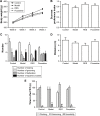Resveratrol ameliorates chronic unpredictable mild stress-induced depression-like behavior: involvement of the HPA axis, inflammatory markers, BDNF, and Wnt/β-catenin pathway in rats
- PMID: 29138567
- PMCID: PMC5667793
- DOI: 10.2147/NDT.S150028
Resveratrol ameliorates chronic unpredictable mild stress-induced depression-like behavior: involvement of the HPA axis, inflammatory markers, BDNF, and Wnt/β-catenin pathway in rats
Abstract
Classic antidepressant drugs are modestly effective across the population and most are associated with intolerable side effects. Recently, numerous lines of evidence suggest that resveratrol (RES), a natural polyphenol, possesses beneficial therapeutic activity for depression. The aim of the present study was to explore whether RES exhibits an antidepressant-like effect in a depression model and to explore the possible mechanism. A depression model was established via chronic unpredictable mild stress (CUMS), after which the model rats in the RES and fluoxetine groups received a daily injection of RES or fluoxetine, respectively. The sucrose preference test, open field test, and forced swimming test were used to explore the antidepressant-like effects of RES. The activity of the hypothalamic-pituitary-adrenal (HPA) axis was evaluated by detecting the plasma corticosterone concentration and hypothalamic mRNA expression of corticotrophin-releasing hormone. The plasma interleukin-6 (IL-6), C-reactive protein (CRP), and tumor necrosis factor-α (TNF-α) concentrations were measured by enzyme-linked immunosorbent assay. Hippocampal protein expression of brain-derived neurotrophic factor (BDNF) and the Wnt/β-catenin pathway were analyzed by western blot. The results showed that RES relieved depression-like behavior of CUMS rats, as indicated by the increased sucrose preference and the decreased immobile time. Rats that received RES treatment exhibited reduced plasma corticosterone levels and corticotrophin-releasing hormone mRNA expression in the hypothalamus, suggesting that the hyperactivity of the HPA axis in CUMS rats was reversed by RES. Moreover, after RES treatment, the rats exhibited increased plasma IL-6, CRP, and TNF-α concentrations. Furthermore, RES treatment upregulated the hippocampal protein levels of BDNF and the relative ratio of p-β-catenin/β-catenin while downregulating the relative ratio of p-GSK-3β/GSK-3β. Our findings suggest that RES improved depressive behavior in CUMS rats by downregulating HPA axis hyperactivity, increasing BDNF expression and plasma IL-6, CRP, and TNF-α concentrations, and regulating the hippocampal Wnt/β-catenin pathway.
Keywords: C-reactive protein; Wnt/β-catenin pathway; brain-derived neurotrophic factor; chronic unpredictable mild stress; depression; hypothalamus–pituitary–adrenal axis; interleukin-6; resveratrol; tumor necrosis factor-α.
Conflict of interest statement
Disclosure The authors report no conflicts of interest in this work.
Figures





Similar articles
-
Resveratrol Ameliorates the Anxiety- and Depression-Like Behavior of Subclinical Hypothyroidism Rat: Possible Involvement of the HPT Axis, HPA Axis, and Wnt/β-Catenin Pathway.Front Endocrinol (Lausanne). 2016 May 24;7:44. doi: 10.3389/fendo.2016.00044. eCollection 2016. Front Endocrinol (Lausanne). 2016. PMID: 27252679 Free PMC article.
-
Ro41-5253, a selective antagonist of retinoic acid receptor α, ameliorates chronic unpredictable mild stress-induced depressive-like behaviors in rats: Involvement of regulating HPA axis and improving hippocampal neuronal deficits.Brain Res Bull. 2019 Mar;146:302-309. doi: 10.1016/j.brainresbull.2019.01.022. Epub 2019 Jan 31. Brain Res Bull. 2019. PMID: 30711623
-
Orcinol glucoside produces antidepressant effects by blocking the behavioural and neuronal deficits caused by chronic stress.Eur Neuropsychopharmacol. 2014 Jan;24(1):172-80. doi: 10.1016/j.euroneuro.2013.05.007. Epub 2013 Jul 6. Eur Neuropsychopharmacol. 2014. PMID: 23838013
-
BDNF Unveiled: Exploring Its Role in Major Depression Disorder Serotonergic Imbalance and Associated Stress Conditions.Pharmaceutics. 2023 Aug 3;15(8):2081. doi: 10.3390/pharmaceutics15082081. Pharmaceutics. 2023. PMID: 37631295 Free PMC article. Review.
-
Study on the Mechanism for SIRT1 during the Process of Exercise Improving Depression.Brain Sci. 2023 Apr 25;13(5):719. doi: 10.3390/brainsci13050719. Brain Sci. 2023. PMID: 37239191 Free PMC article. Review.
Cited by
-
Role of inflammatory cytokines and the gut microbiome in vascular dementia: insights from Mendelian randomization analysis.Front Microbiol. 2024 Aug 23;15:1398618. doi: 10.3389/fmicb.2024.1398618. eCollection 2024. Front Microbiol. 2024. PMID: 39247699 Free PMC article.
-
Autophagy-Based Hypothesis on the Role of Brain Catecholamine Response During Stress.Front Psychiatry. 2020 Sep 17;11:569248. doi: 10.3389/fpsyt.2020.569248. eCollection 2020. Front Psychiatry. 2020. PMID: 33093837 Free PMC article. Review.
-
Integrated metabolomics and lipidomics profiling of hippocampus reveal metabolite biomarkers in a rat model of chronic unpredictable mild stress-induced depression.Ann Transl Med. 2019 Dec;7(23):781. doi: 10.21037/atm.2019.11.21. Ann Transl Med. 2019. PMID: 32042797 Free PMC article.
-
Antidepressive Effect of Natural Products and Their Derivatives Targeting BDNF-TrkB in Gut-Brain Axis.Int J Mol Sci. 2022 Nov 29;23(23):14968. doi: 10.3390/ijms232314968. Int J Mol Sci. 2022. PMID: 36499295 Free PMC article. Review.
-
Chinese Herbal Medicine for the Treatment of Depression: Effects on the Neuroendocrine-Immune Network.Pharmaceuticals (Basel). 2021 Jan 14;14(1):65. doi: 10.3390/ph14010065. Pharmaceuticals (Basel). 2021. PMID: 33466877 Free PMC article. Review.
References
-
- Baldessarini RJ. The basis for amine hypotheses in affective disorders. A critical evaluation. Arch Gen Psychiatry. 1975;32(9):1087–1093. - PubMed
-
- Ford AC. In irritable bowel syndrome, antispasmodics and antidepressants improve abdominal pain and global assessment and symptom scores, but there is no evidence for the effectiveness of bulking agents. Evid Based Med. 2012;17(4):114–115. - PubMed
-
- Givens CJ. Adverse drug reactions associated with antipsychotics, antidepressants, mood stabilizers, and stimulants. Nurs Clin North Am. 2016;51(2):309–321. - PubMed
-
- Swaab DF, Bao AM, Lucassen PJ. The stress system in the human brain in depression and neurodegeneration. Aging Res Rev. 2005;4(2):141–194. - PubMed
LinkOut - more resources
Full Text Sources
Other Literature Sources
Research Materials
Miscellaneous

